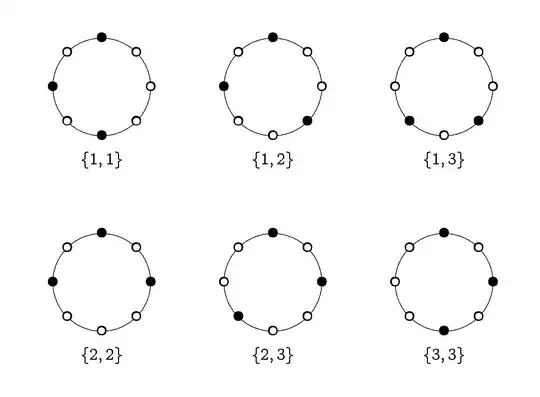I'm trying to understand the following solution (based on http://citeseerx.ist.psu.edu/viewdoc/summary?doi=10.1.1.96.8324).
Problem: What is the number of ways of selecting $k$ objects from $n$, which are arrayed in a circle and are not consecutive? (A different solution is at Choose K items from N in a circle)
Given Solution: There are $n$ choices for the first object selected. Next, we must select the remaining $\color{green}{k - 1}$ objects. In addition, to prevent consecutiveness, we must select the $\color{brown}{k}$ objects which lie between the $\color{green}{k - 1}$ objects.
Therefore, the number of objects UNaccounted for $:= U = (n - 1) - (\color{green}{k - 1} + \color{brown}{k}) = n - 2k$. We can only place these $U$ objects in between the selected $\color{brown}{k}$ objects, so the number of possible positions for these $U$ objects is $\color{brown}{k}$.
Therefore, the number of ways to select these $U$ positions = $\left( \begin{matrix} { k - 1 + U} \\ {U} \\ \end{matrix} \right)$. (Rest of soln omitted).
I don't understand this last sentence. I understand that we are choosing $U$ objects, but how are we choosing from $(k - 1 + U)$? Where did this number come from?
As a recourse to the general case, I appealed to the simpler case where $n = 8$ and $k = 3$. Then $U$ = 2 and the number of ways to select these $U$ positions = $\left( \begin{matrix} { 4} \\ {2} \\ \end{matrix} \right)$. But I can't see where 4 comes from either (We need to place U1 and U2 so I understand why we're choosing 2.). Here's my picture, where green denotes the $\color{green}k$ selected objects and black denotes the objects unaccounted for:

In response to Prof Scott's post, I thought to add that the bars in the stars-and-bars analogy aren't actually the $\color{brown}{\text{brown separators}}$ drew above. The bars, which I draw in pink below, actually separate the intervals between the $\color{brown}{\text{brown separators}}$. Pictorially: 
